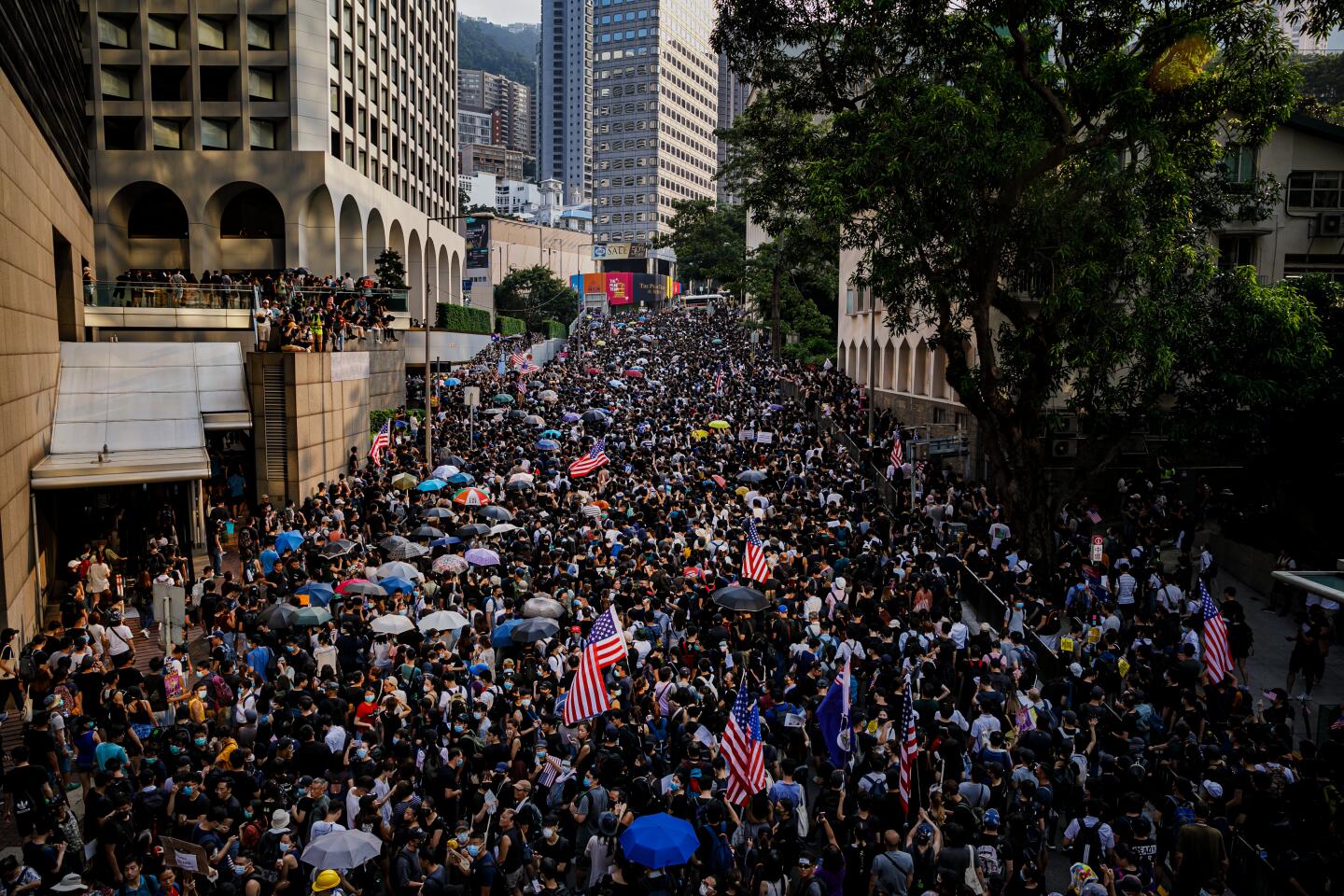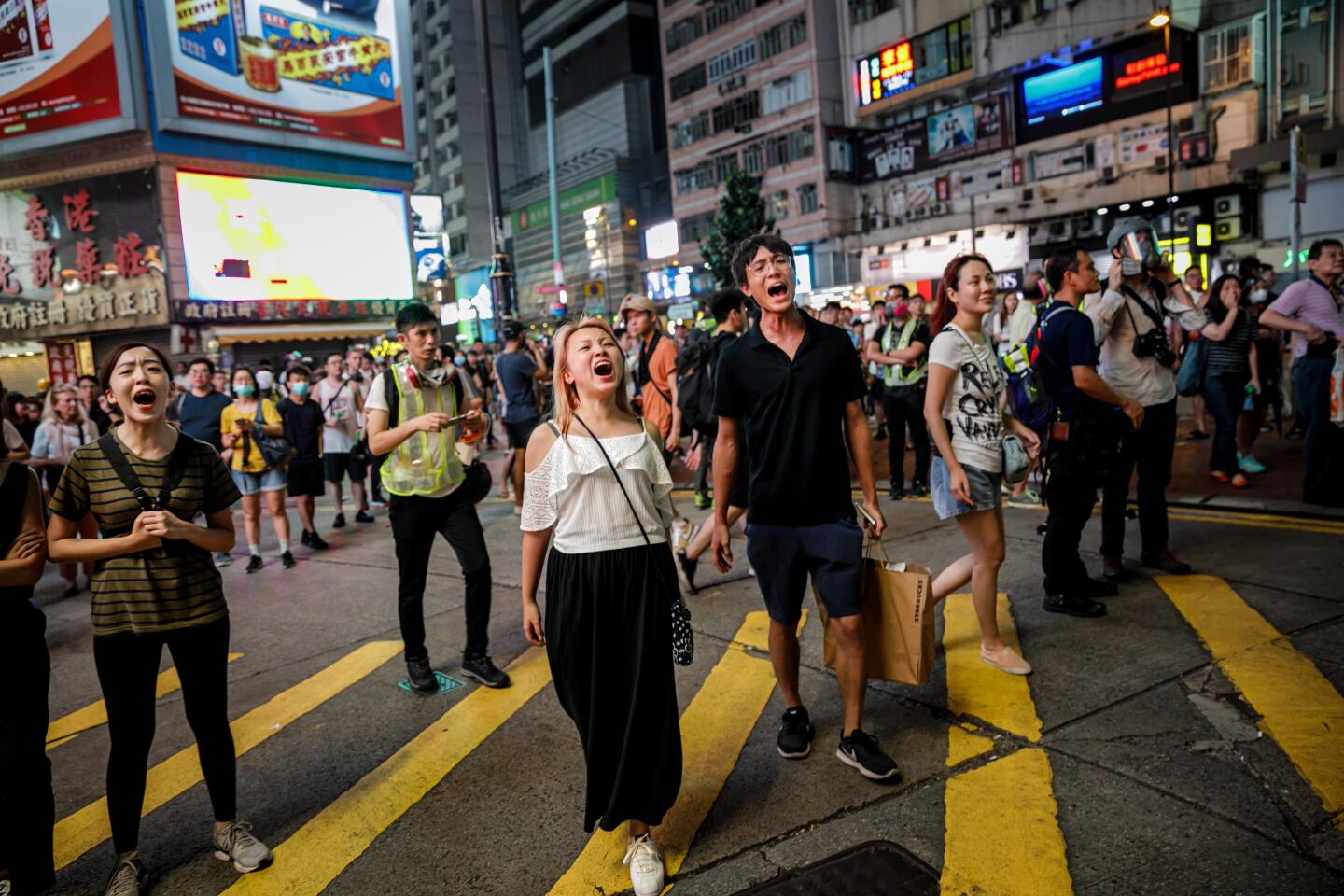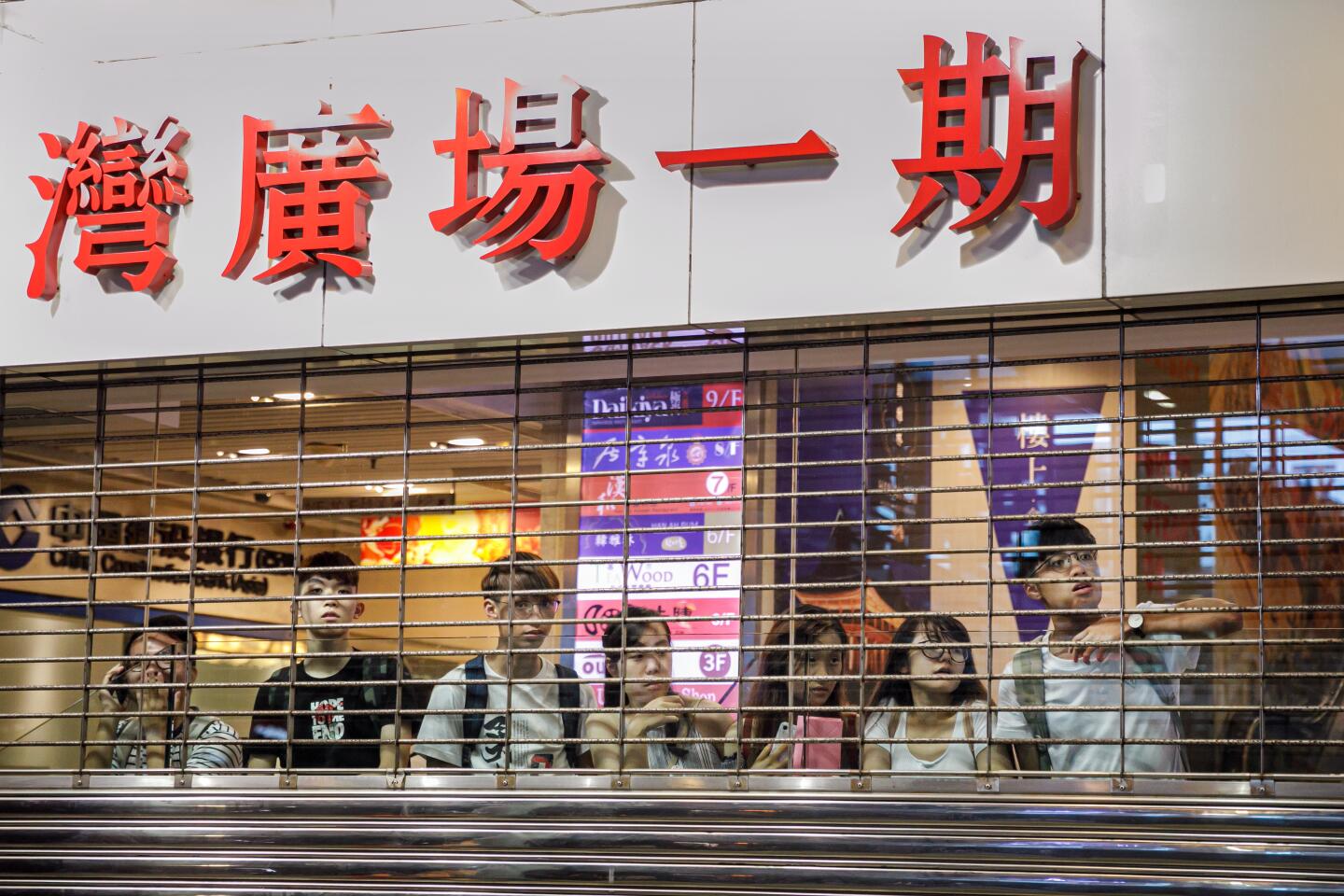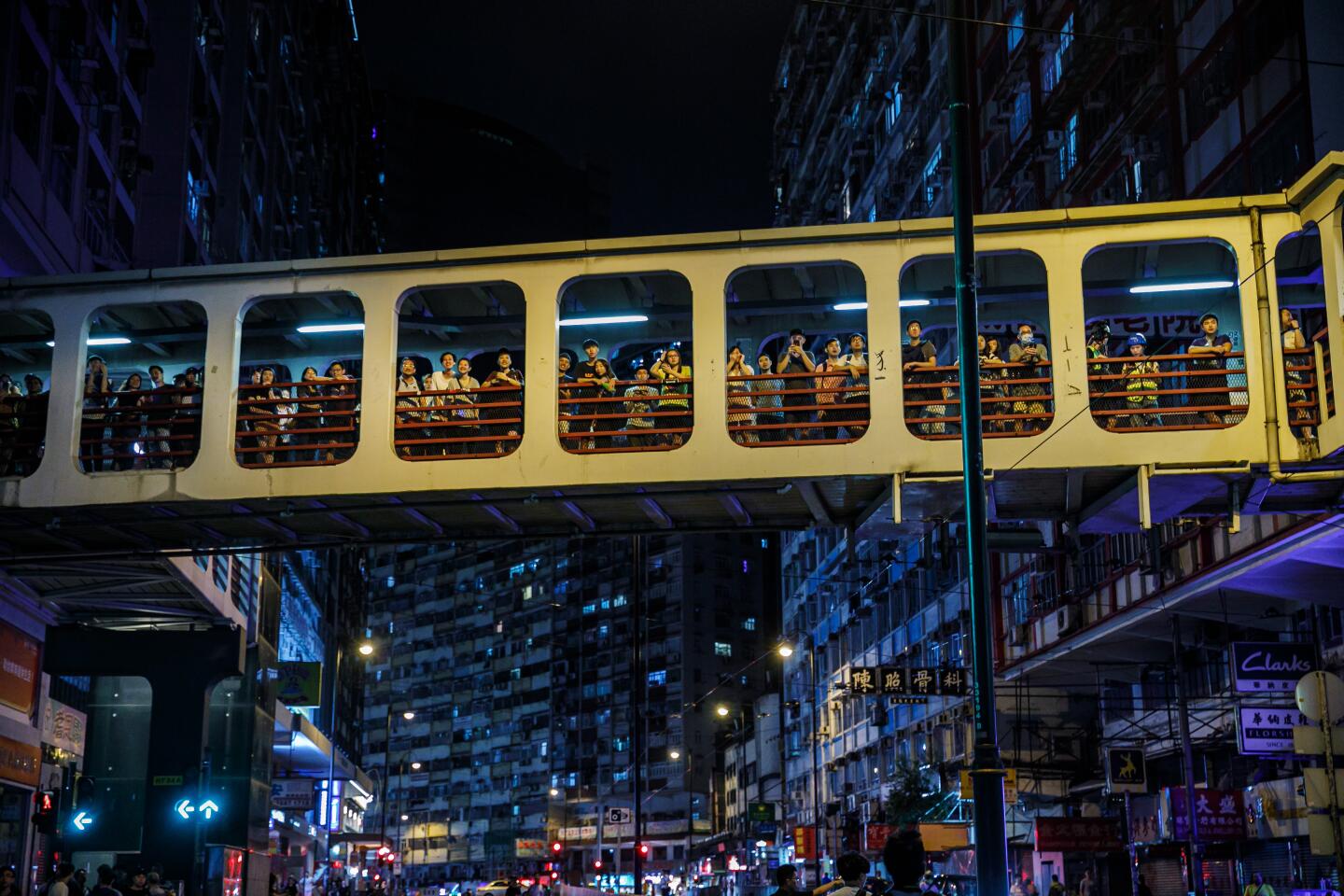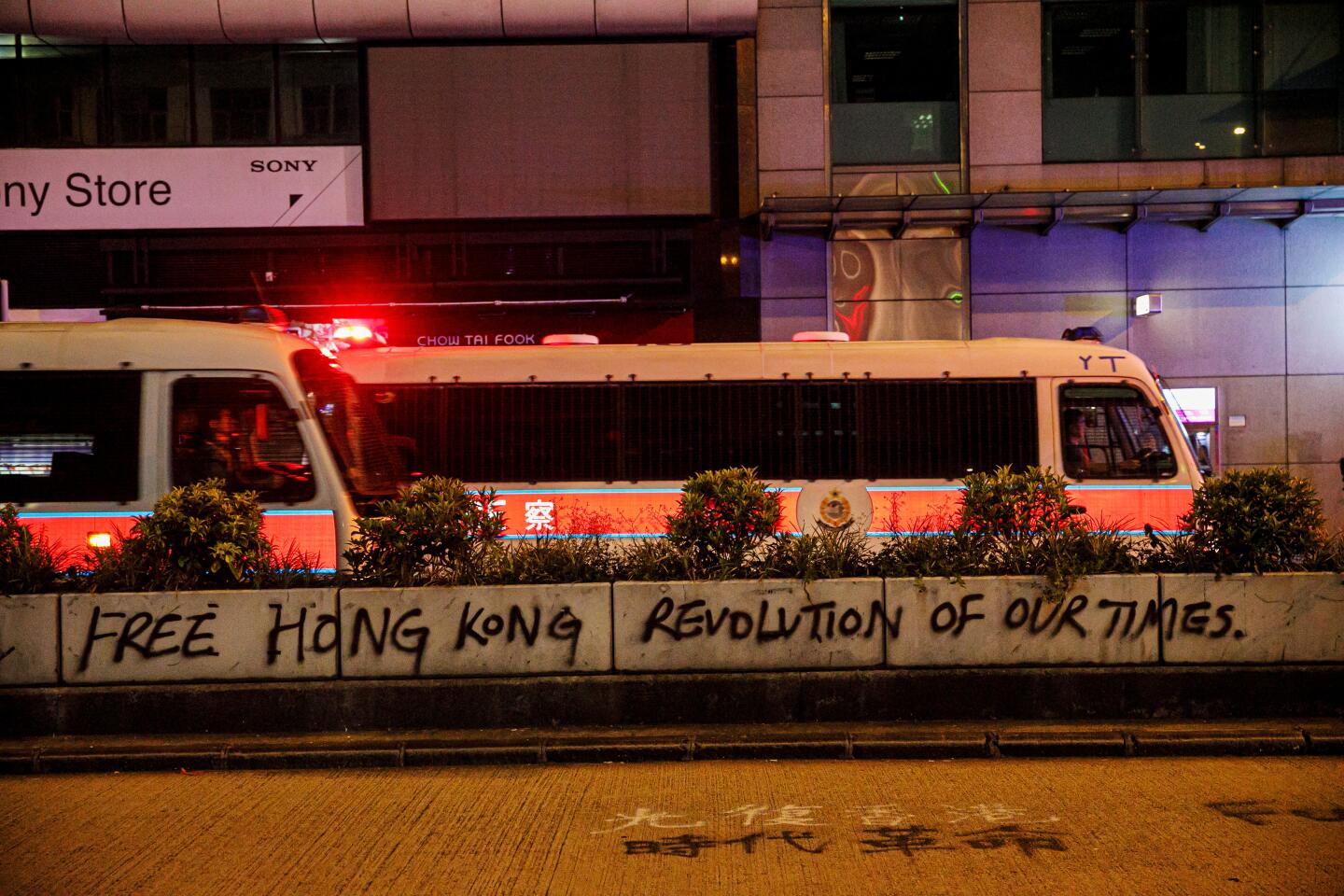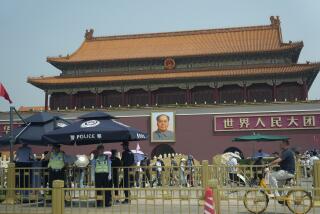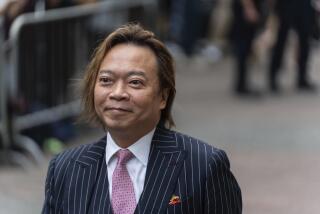‘The whole system is rotten. We want to tear it down’: Hong Kong protests blaze on
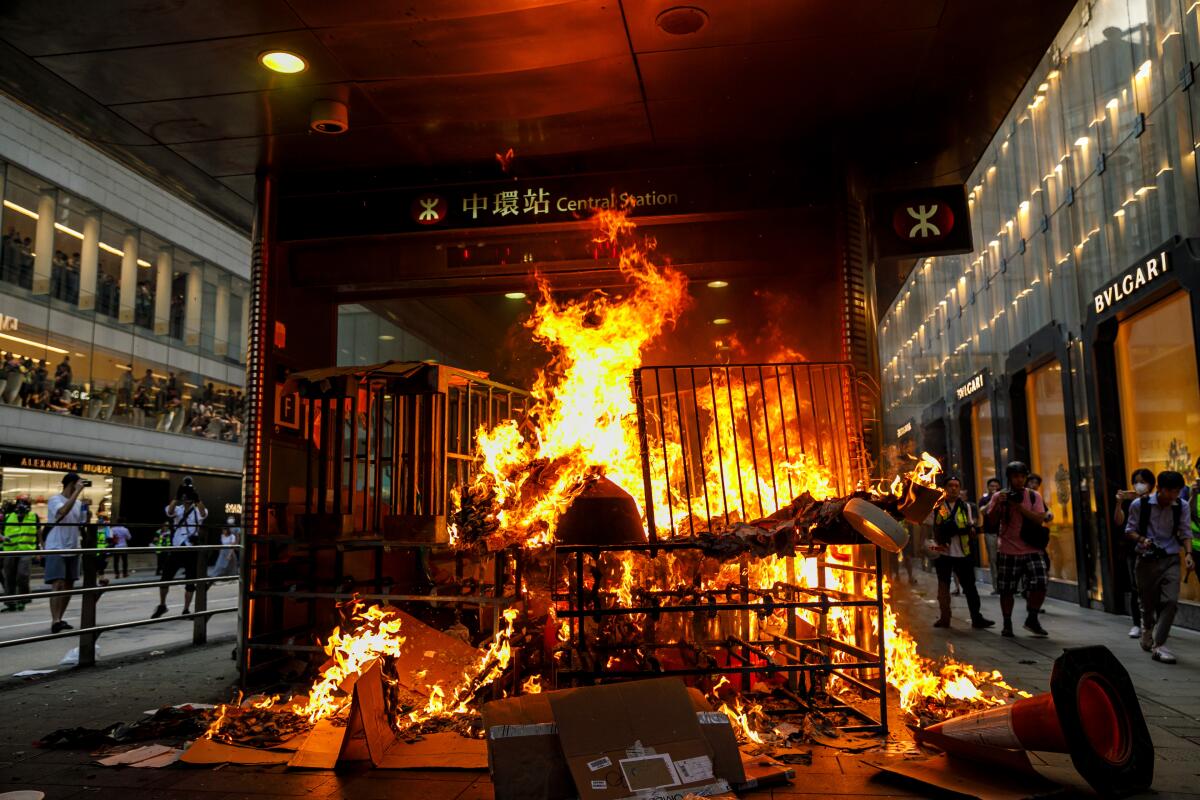
- Share via
HONG KONG — It took Hong Kong Chief Executive Carrie Lam 13 weeks to withdraw the extradition bill that sparked the city’s summer of unrest. But her announcement failed to stop the protests for even one night.
Demonstrators have continued to rally, march, clash with police and, on Sunday, wave American flags while singing the U.S. national anthem in an appeal for help from Washington.
“Resist Beijing, liberate Hong Kong! Sanction China, now or never! Pray for U.S., pray for us!” chanted tens of thousands of protesters who marched to the U.S. Consulate on Sunday afternoon in a call for Congress to pass legislation that would strengthen U.S. support for democratization and human rights in Hong Kong.
What began as peaceful protests over a bill that would allow people in the semiautonomous territory to be deported to mainland China for trial has become a fight for liberal versus authoritarian values.
Hong Kong is “at the front line of an expansionist China,” said Leung, 25, who, like most other protesters, asked that his full name be withheld to protect his safety. He wore a full suit in a sign of respect for what he said the United States represented.
“It’s not just about fighting back against one country but against the spread of communism and authoritarianism,” Leung said. “It’s Hong Kong and Xinjiang today, but where will be next?”
House Speaker Nancy Pelosi said in a statement Wednesday that the people of Hong Kong deserved “justice, real autonomy and freedom of fear” and that Congress looked forward to “swiftly advancing” legislation.
President Trump, on the other hand, has expressed confidence in Chinese President Xi Jinping, calling him a “great leader” who can “quickly and humanely solve the Hong Kong problem.”
Trump also — perhaps inadvertently — echoed Chinese rhetoric on Hong Kong protests by calling them “riots” and affirming that Hong Kong is a domestic Chinese problem.”Hong Kong is a part of China; they’ll have to deal with that themselves,” he said to reporters in August.
The Hong Kong protest movement, pushed forward largely by people in their teens and 20s with no identifiable leader, has adopted more aggressive tactics while reiterating demands for the investigation of police brutality, amnesty for more than 1,000 arrested protesters, and electoral reform.
Xi has responded negatively. In a recent speech, he exhorted Communist Party cadres to “struggle” harder against challenges to China’s sovereignty and party interests, singling out Hong Kong as a key area of struggle.
With Beijing doubling down, Hong Kongers have increasingly lost trust in government, the police force and long-standing institutions.
Tens of thousands of students and workers went on strike in recent days as the new school year began. At one secondary school’s back-to-school opening ceremony, students sang “Do You Hear the People Sing?” — the revolutionary song from “Les Miserables” — above the Chinese national anthem.
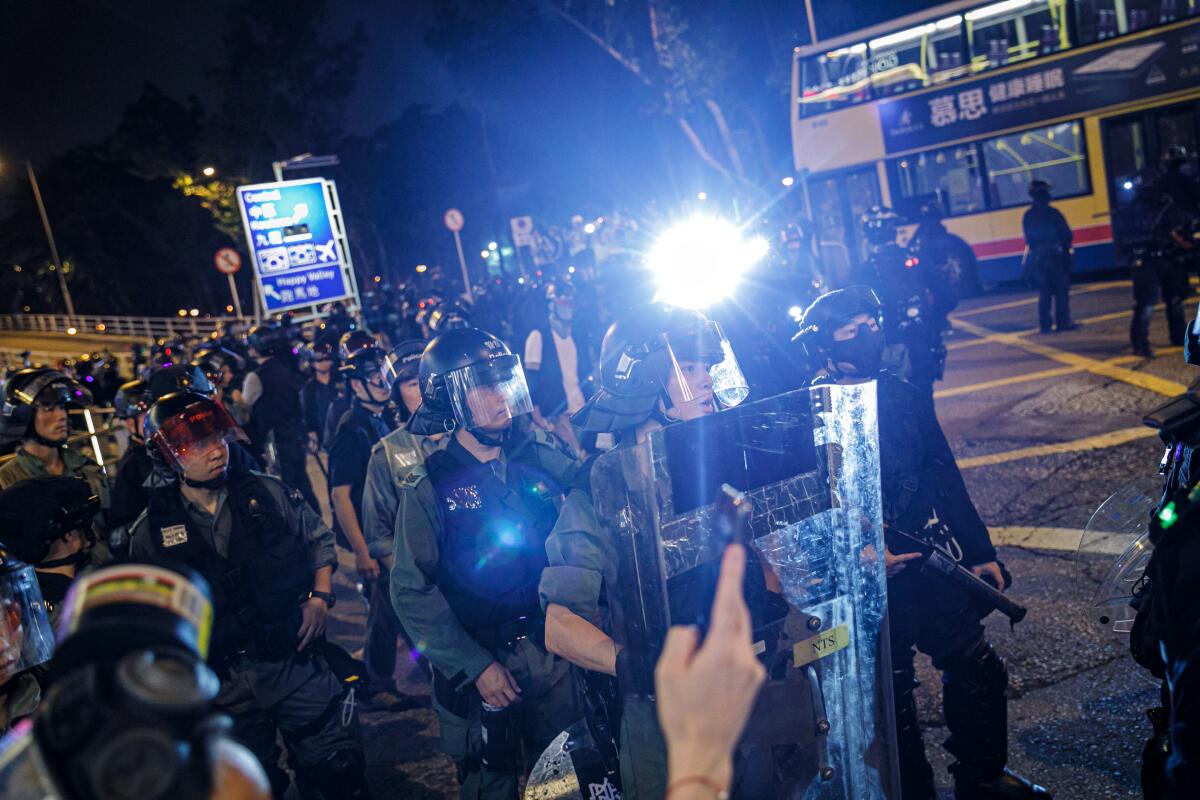
At the Chinese University of Hong Kong, students hung a banner over the side of a building: “I’d rather speak up and die than remain silent and live.”
At 10 o’clock each night, residents lean out of their windows in neighborhoods across the city to scream anti-government slogans and their core demands. “Reclaim Hong Kong, revolution of our times!” they yell, some in anger at police tactics, others in resistance to Beijing’s background control.
Unverified rumors of police having killed protesters inside a subway station on Aug. 31 have sparked spontaneous protests at the station and nightly clashes with police.
Hong Kong’s government has denied that any protesters died during police clashes at Prince Edward Station. But a wall of flowers fills the subway exit.
Protesters knelt inside the subway station for hours last week, begging the transportation authority to release CCTV video of the hours when police were inside.
Later, protests turned into clashes with police, who destroy the memorial each night only to see new white flowers and incense return each day.
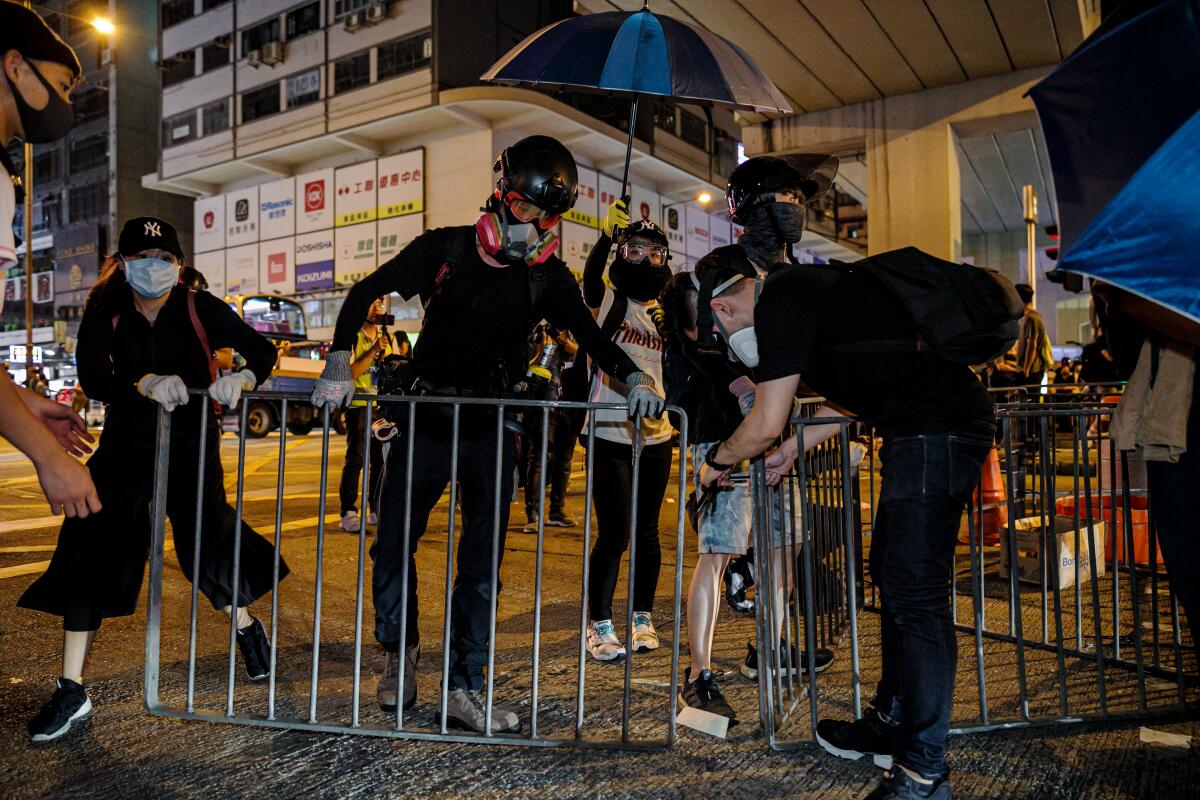
“A debt of blood must be paid in blood,” reads a sign above the subway entrance.
Cassie, 19, a protester wearing jean shorts and a surgical mask, laid fresh flowers at the subway station as police charged at protesters nearby Sunday night.
“I believe people were beaten to death by police on Aug. 31. Because they refuse to release the CCTV footage,” she said. “They have something to hide.”
Other protesters vandalized the interior of Hong Kong’s Central subway station, smashing glass windows at its entrances and setting a barricade on fire.
Tony, 30, a resident, said he disagreed with setting fires or attacking police — especially on a day when Hong Kongers were appealing for help from the United States.
“I support the protests, but I don’t like the idea of coming out inspired by hate or revenge,” he said. “The future of Hong Kong already looks so grim. We need to inspire hope in our people.”
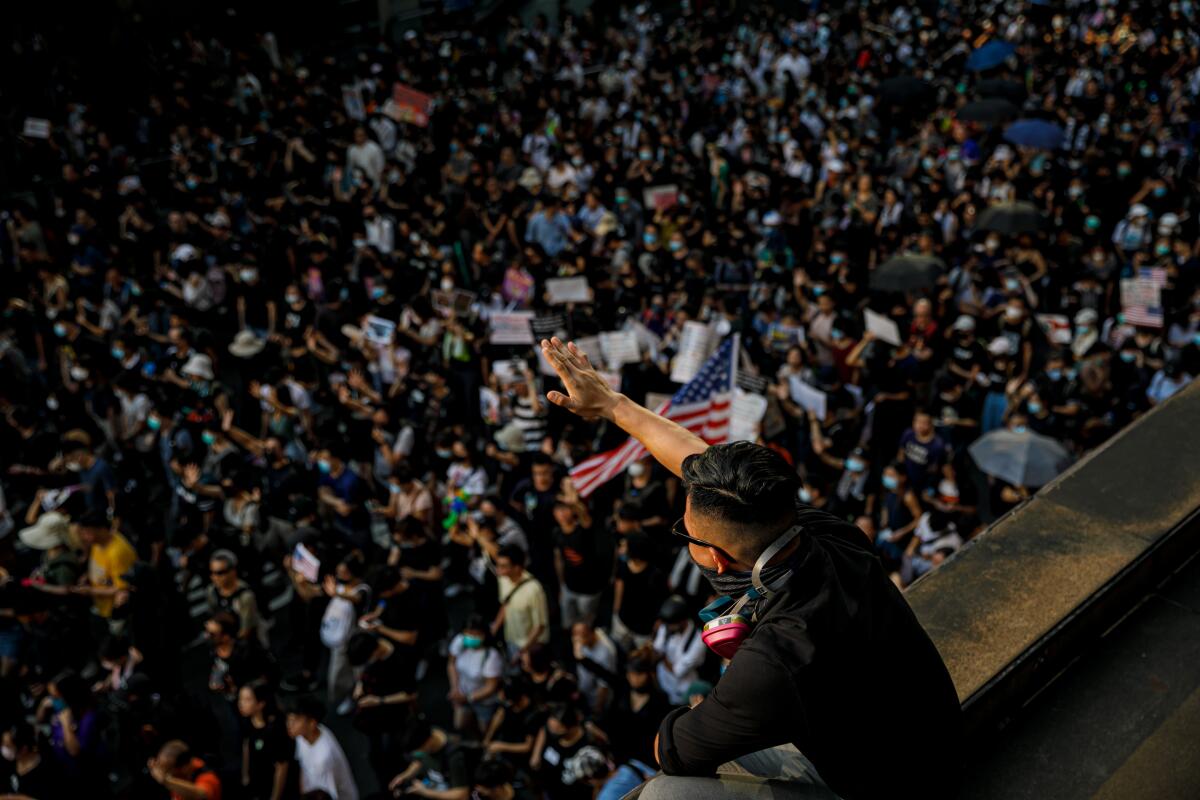
But he also criticized the police, saying their aggression had shattered residents’ sense of safety.
“There’s just no trust in them left,” he said. “They act above the law now, surrounding and beating people even after they’re subdued. They think they are the court and the prison. You’re guilty until proven innocent.”
A series of surveys conducted by the Chinese University of Hong Kong’s Center for Communication and Public Opinion have found that more and more protesters have become comfortable with radical tactics as the crisis continues.
The percentage of protesters who agreed that radical tactics were understandable if the government refused to listen rose to 90% from 70% between June and August.
The protesters Sunday were urging passage in Washington of the Hong Kong Human Rights and Democracy Act, a bipartisan bill that would freeze assets of Hong Kong officials who harm civic freedoms and deny them entry to the United States.
The bill also would require an annual certification of Hong Kong’s autonomy from the secretary of State.
Some protesters also appealed directly to Trump, hoisting signs that read, “President Trump, please liberate Hong Kong.”
Whether he or others in Washington listen, Hong Kong’s protests are not ending anytime soon.
“It’s about more than the bill now,” said Eric, 28, a protester who spoke to the Los Angeles Times just after he’d changed from all-black to ordinary clothes, trying to escape police charging at demonstrators during the night. “After all the bloodshed by the police, they need to pay for it.
“The whole system in Hong Kong is rotten, from top to bottom. We want to tear it down and start fresh.”
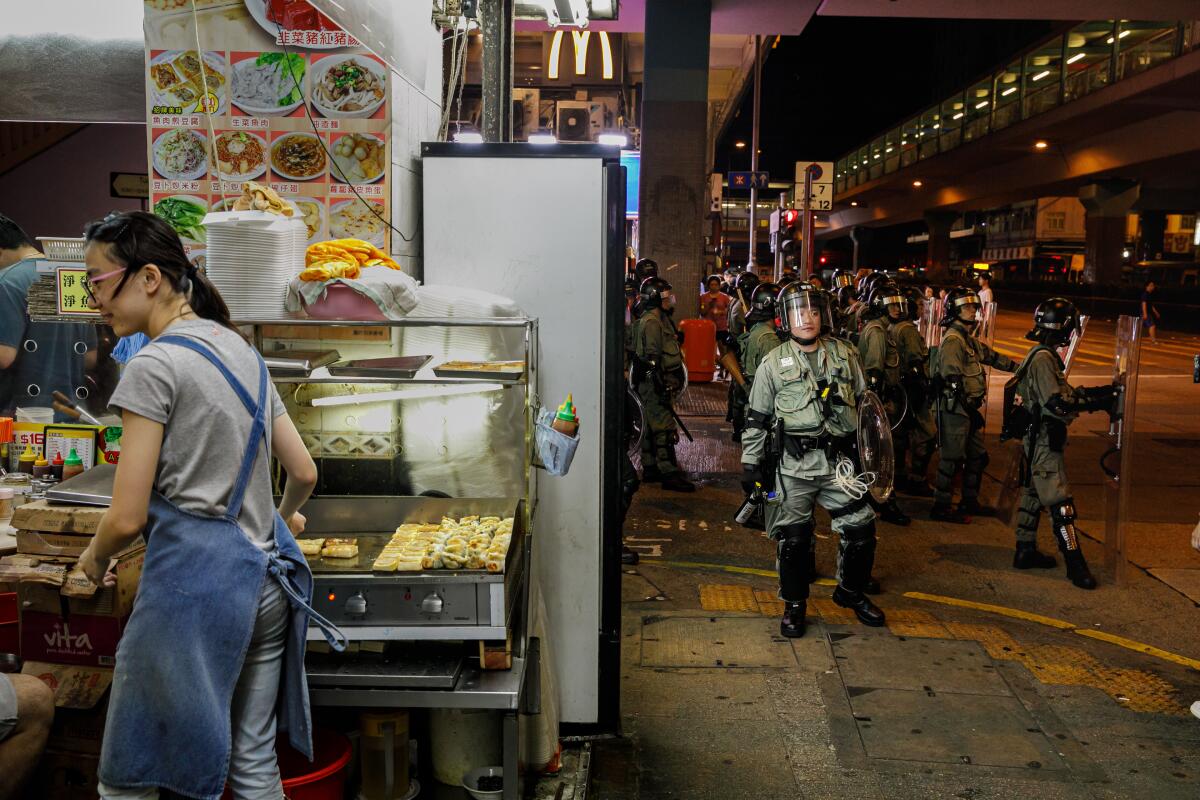
Special correspondent Ho Kilpatrick reported from Hong Kong and Times staff writer Su from Beijing.
More to Read
Sign up for Essential California
The most important California stories and recommendations in your inbox every morning.
You may occasionally receive promotional content from the Los Angeles Times.
